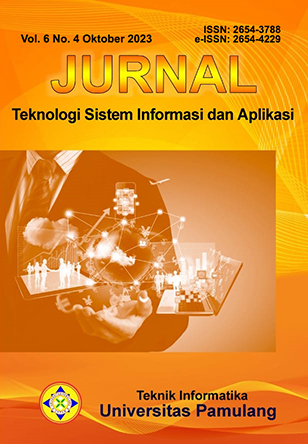Visualisasi Data Pemetaan Daerah Hipertensi Menggunakan Algoritma K-Means
Keywords:
Data Visualization, Hypertension, K-Means Clustering, Tableau, RapidminerAbstract
According to data from the Ministry of Health in 2019, the number of hypertension patients continues to rise and is projected to reach approximately 1.5 billion by 2025. Additionally, an estimated 9.4 million people die each year due to hypertension and its complications. The current challenge is the difficulty faced by the public in understanding the information contained in the data, leading to a decrease in awareness of the importance of maintaining health to prevent and control hypertension. This research proposes the use of the K-Means clustering algorithm with spatial data visualization techniques to communicate information from the data more effectively to the public. The proposed method allows the K-Means clustering algorithm to group regions based on hypertension characteristics such as prevalence and risk factors, while spatial data visualization techniques are used to display the data in the form of a geographic map of hypertension areas. The results of applying this method show that the K-Means clustering algorithm produces five clusters that reflect different characteristics of hypertension, and spatial data visualization techniques generate a geographic map of hypertension areas with five different colors representing the highest to lowest characteristic groups of hypertension. This research provides a clear and easily understandable way to communicate information from the data, thereby assisting the public in efforts to prevent and control hypertension and its risk factors.
References
Dewi, D. A. I. C., & Pramita, D. A. K. (2019). Analisis Perbandingan Metode Elbow dan Silhouette pada Algoritma Clustering K-Medoids dalam Pengelompokan Produksi Kerajinan Bali. Matrix : Jurnal Manajemen Teknologi Dan Informatika, 9(3), 102–109. https://doi.org/10.31940/matrix.v9i3.1662
Faujia, R. A., & Subarkah, M. Z. (2022). Analisis Klaster K-Means Dan Visualisasi Data Spasial Berdasarkan Karakteristik Persebaran Covid-19 Dan Pelanggaran Protokol Kesehatan Di Jawa Tengah. Seminar Nasional Official Statistics, 2022(1), 813–822. https://doi.org/10.34123/semnasoffstat.v2022i1.1222
Irawan, D., Siwi, A. S., & Susanto, A. (2020). Analisis Faktor-Faktor yang Memengaruhi Kejadian Hipertensi. Journal of Bionursing, 2(3), 164–166. https://doi.org/10.20884/1.bion.2020.2.3.70
Mulyani, A., & Kartini. (2023). VISUALISASI DATA TICKETING SERVICEDESK DENGAN DASHBOARD PADA PT BRANTAS ABIPRAYA (PERSERO). 7(2), 289–300. https://doi.org/10.52362/jisamar.v7i2.1074
Purwoko, S., Cahyati, W. H., & Farida, E. (2020). Pemanfaatan Sistem Informasi Geografis ( SIG ) dalam Analisis Sebaran Penyakit Menular TB BTA Positif Di Jawa Tengah Tahun.
Siregar, H. D., Marlindawani, J., Harefa, K., Ketaren, O., & Rohana, T. (2021). FAKTOR-FAKTOR YANG BERHUBUNGAN DENGAN HIPERTENSI DI PUSKESMAS TELADAN KOTA MEDAN TAHUN 2021. 7(2), 985–1001.
Downloads
Published
How to Cite
Issue
Section
License
Copyright (c) 2023 Haris Andika Arbi, Raissa Amanda Putri

This work is licensed under a Creative Commons Attribution-NonCommercial 4.0 International License.
Authors who publish with this journal agree to the following terms:
- Authors retain copyright and grant the journal right of first publication with the work simultaneously licensed under a Creative Commons Attribution License that allows others to share the work with an acknowledgement of the work's authorship and initial publication in this journal.
- Authors are able to enter into separate, additional contractual arrangements for the non-exclusive distribution of the journal's published version of the work (e.g., post it to an institutional repository or publish it in a book), with an acknowledgement of its initial publication in this journal.
- Authors are permitted and encouraged to post their work online (e.g., in institutional repositories or on their website) prior to and during the submission process, as it can lead to productive exchanges, as well as earlier and greater citation of published work (See The Effect of Open Access).
Jurnal Teknologi Sistem Informasi dan Aplikasi have CC BY-NC or an equivalent license as the optimal license for the publication, distribution, use, and reuse of scholarly work.
In developing strategy and setting priorities, Jurnal Teknologi Sistem Informasi dan Aplikasi recognize that free access is better than priced access, libre access is better than free access, and libre under CC BY-NC or the equivalent is better than libre under more restrictive open licenses. We should achieve what we can when we can. We should not delay achieving free in order to achieve libre, and we should not stop with free when we can achieve libre.
This work is licensed under a Creative Commons Attribution-NonCommercial 4.0 International (CC BY-NC 4.0) License
YOU ARE FREE TO:
- Share - copy and redistribute the material in any medium or format
- Adapt - remix, transform, and build upon the material for any purpose, even commercially.
- The licensor cannot revoke these freedoms as long as you follow the license terms



_2020_-_7(2)_2024_-_Thumbnail.png)












